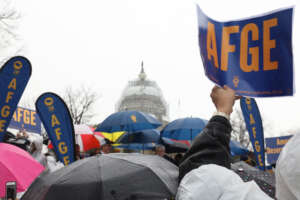

The Department of Housing and Urban Development wants to engage in mid-term negotiations with AFGE over official time.
 The Department of Housing and Urban Development is moving quickly to implement President Donald Trump’s recent executive order on official time by telling federal employee unions they can no longer use federal facilities or resources to do the organizations’ work. And the Social Security Administration and Department of Health and Human Services may be following in their footsteps.
The Department of Housing and Urban Development is moving quickly to implement President Donald Trump’s recent executive order on official time by telling federal employee unions they can no longer use federal facilities or resources to do the organizations’ work. And the Social Security Administration and Department of Health and Human Services may be following in their footsteps.
HUD told the American Federation of Government Employees and the National Federation of Federal Employees that it wants to engage in midterm negotiations to implement the requirements under the EO. But one key proposal submitted by the agency would be for the unions to vacate federal office space by July 15.
“No union representative, when acting on behalf of the union, may be permitted the use of government property or any other agency resources. Such property and resources include office or meeting space, reserved parking spaces, phones, computers, computer systems, copy machines, paper, filing cabinets, keys, scanners, external drives, fax machines, use of printing services, subscriptions to information services (cyberdfeds, etc.) and all other government property or resources,” HUD told AFGE on June 14. “The union shall have until July 15, 2018, to vacate all offices they currently occupy, return all government property they currently possess and cease using government resources. This applies to field and HQ.”
But Debra D’Agostino, a founding partner and attorney with The Federal Practice Group, said HUD’s actions seem less like a proposal and more like a mandate, which would contradict Trump’s order.
The president signed three executive orders on May 25, including one that would limit the amount of time federal employees can spend doing union work during normal office hours. Among the EO’s provisions is a new restriction on union representatives using government office space or property for free or for a reduced cost. Some agencies have set aside space within their buildings for union offices.
She said agencies have 45 days to implement the EO, but section 8(b) also provides that if there is a collective bargaining agreement (CBA) in place with at least one provision that is inconsistent with the Executive Order, the agency must give notice of its intent to alter the CBA and reopen negotiations to obtain provisions consistent with the EO.
“This seems to be the case with HUD’s CBA that affords the union meeting space within the agency facility,” D’Agostino said. “The bottom line, in my opinion, though is that Section 9(a) provides that ‘Nothing in this order shall abrogate any collective bargaining agreement in effect on the date of this order.’ This seems to be exactly what HUD is doing instead of comporting with Section 8(b) to reopen negotiations.”
HUD spokesman Jerry Brown said in an email that HUD is committed to “good faith bargaining” with the unions.
“[H]owever, HUD currently rents additional space for employees to work outside of its designated buildings in locations like Washington D.C., and we also pay rent for union activity space in other locations nationwide,” he said. “Utilizing that space for employees assisting in housing families in need would be a much more efficient use of taxpayer dollars,.”
Holly Salamido, president of AFGE Council 222 representing HUD employees at 40 locations, said new contract negotiations were slated to begin June 19 and the union asked that the changes to office space used for official time work be part of those discussions.
She said HUD management said instead they intended to issue a midterm bargaining notice as they viewed these matters as separate and “distinct” from the term negotiations.
“This is totally illegal — we have a contract in place, and per the section ‘Duration of the Agreement,’ that contract remains in place until we finish negotiating the new one,” she said by email.
In the letter to AFGE, HUD management wrote that the proposals are “preliminary bargaining proposals and are not to be considered all of the proposals that management may submit. A complete list of proposals may be presented prior to or at the time of bargaining in accordance with Article 49.06. This midterm proposal in entirely distinct and separate from the term renegotiation that is currently also taking place. In accordance with Article 49 you may demand to bargain these proposed changes within 15 days.”
The Washington Post first reported HUD’s decision to ask AFGE to leave federal facilities for all union activity.
Management at HHS and SSA also are asking for changes to current contracts. The Washington Post reported SSA wants to renegotiate 21 separate issues with AFGE, while HHS told the National Treasury Employees Union that the union must start paying rent for office space in federal facilities.
“There’s nothing [in the EO] that allows an agency to today go to the union and say, ‘OK, under the contract, we’ve been giving you free office space. You have to start paying rent on it starting next week,’” said Bill Wiley, former chief counsel to the chairman of the Merit Systems Protection Board and now attorney and co-founder of the Federal Law Training Group.
He spoke with Federal News Radio soon after the White House released the EOs in May.
“In other words, management is bound by what it has in current agreements, but as those agreements expire or if there’s a midterm re-opener to an agreement, the executive order is saying … management is supposed to refuse to agree to any union proposal that would provide the union, for example, free office space,” Wiley said.
The decision by HUD, and possibly HHS and SSA, to begin implementing the EOs ahead of negotiations comes as data from the Office of Personnel Management shows most agencies already meet the requirements of the president’s mandate.
The EO mandates employees spend no more than one hour per employee per year.
The pushback against all three executive orders is in full swing. Over the last two weeks, AFGE and the National Treasury Employees Union filed individual lawsuits while NFFE and 12 other unions filed a joint lawsuit seeking to end the EOs. Meanwhile, 21 House Republicans also wrote to the president asking him to rescind the orders.
AFGE’s Salamido said the union is considering its options for how to address HUD’s mid-term renegotiation proposals. She said there is concern that the Trump administration is closing down avenues of recourse for federal unions.
“Under the Federal Labor Relations statute, the FLRA can only issue a complaint for unfair labor practices like these through its general counsel. The Trump administration has deliberately refused to appoint a general counsel to the FLRA since early 2017,” Salamido said. “It’s deliberate, and it undermines the whole statutory scheme. The agency knows this, so they feel they can blatantly violate the Federal Labor Relations statute. There is a lawsuit pending on just this issue – whether the union has basically exhausted its administrative remedies at the FLRA because there is no general counsel there to issue complaints (by design).”
Copyright © 2025 Federal News Network. All rights reserved. This website is not intended for users located within the European Economic Area.
Jason Miller is executive editor of Federal News Network and directs news coverage on the people, policy and programs of the federal government.
Follow @jmillerWFED


